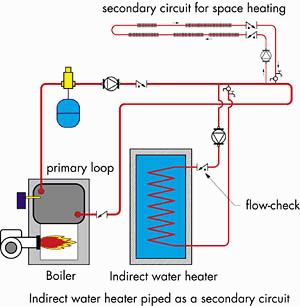The 125F test is to see if it can operate at 95% efficiency in in your system without short-cycling, since short-cycling is one of your concerns. To get that type of efficiency out of it, the entering water at the boiler has to be under 120F, with an average water temp in the fin-tube of about 120F:
At an average water temperature of 120F (125F out of the boiler, 115F return) you'll be well into the condensing range and getting ~95% combustion efficiency out of it, but the baseboard itself is only emitting ~
200 BTU/hr per running foot of length. At it's minimum firing rate the output of the WHN055 is about 10,500 BTU/hr, so at those low very efficient temperatures it takes 10,500/200= 53 feet of baseboard to emit that much heat with NO cycling.
If there is less baseboard than that and the setpoint if 125F more heat is going into the system than is being emitted, so the water temperature will rise until the boiler detects that it's above the setpoint, and turns the burner off, then waits until it falls into range again. Depending on the differential and offset numbers, just how much above the setpoint it turns off, and how far below it will fall before re-firing. (Just how the manufacturer defines those terms will determine which is the more important term to tweak.)
Fin tube baseboard has very little water volume, and thus low thermal mass. There is at least some amount of water in the boiler and distribution plumbing, at 8.34lbs per gallon it will add up to something. The reason it matters is this:
Say there is 4 gallons of water in the system, including all baseboard, the boiler, the distribution plumbing, that's ~33lbs. If the boiler is putting in 10,500 BTU/hr and the baseboard is only emitting 8500 BTU/hr of heat in to the rooms you have 2000 BTU/hr (33 BTU per minute) of "extra" heat going into that 33lbs.
A BTU is the amount of heat it takes to raise a pound of water one degree F. If the temperature swing is programmed so tight that it can only rise 2F before the burner shuts down it takes only (2F x 33lbs)/33BTU per minute= 2 minutes, which is a very short burn. But if it's set up for 5F temperature swings it'll take 5 minutes, which is fine.
When the return water temps coming back to the boiler are above 125-130F the most you'll get out of it is 86-87% efficiency, so it's nice to be able to run in the lower temperature ranges whenever possible, which is one of the major reasons to use an outdoor reset approach rather than manually setting the temperatures.
This is spelled out in some detail in
this bit o' bloggery. The simple napkin math model isn't the whole story (reality is a bit more complicated than that), but it doesn't lie either.


